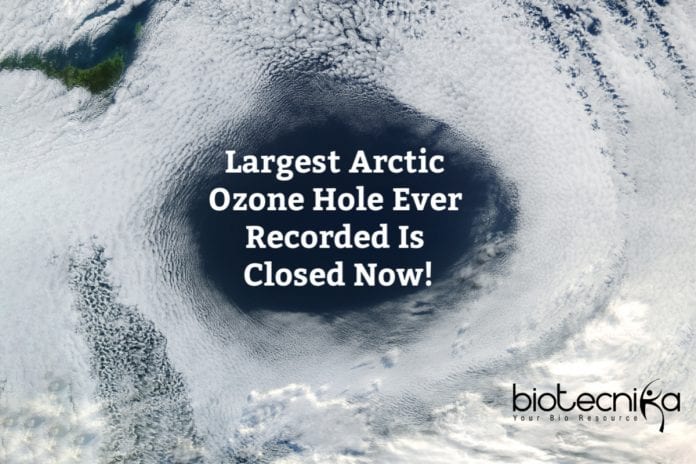The Largest Arctic Ozone Hole Closed Now
A record-breaking ozone hole has healed just as suddenly as it first formed. This ozone hole that first opened up earlier last month was the largest ozone hole to ever open up over the Arctic, and it has now closed.
The closure was announced last week by the scientists monitoring this “unprecedented” hole at the Copernicus Atmospheric Monitoring Service (CAMS). Researchers said that the reason for the ozone hole closing not likely to be due to the pandemic even though the lockdown has lead to a significant reduction in air pollution.
The unprecedented 2020 northern hemisphere #OzoneHole has come to an end. The #PolarVortex split, allowing #ozone-rich air into the Arctic, closely matching last week’s forecast from the #CopernicusAtmosphere Monitoring Service.
More on the NH Ozone hole➡️https://t.co/Nf6AfjaYRi pic.twitter.com/qVPu70ycn4
— Copernicus ECMWF (@CopernicusECMWF) April 23, 2020
CAMS also said that the ozone hole probably had nothing to do with the COVID-19 lockdowns. It is not related to air quality changes, it’s been driven by an unusually strong and long-lived polar vortex. The ozone hole has closed now as the intense polar vortex has ended. The same conditions are not expected to occur the next
year, it added.In March, the ozone levels above the Arctic reached a record low, according to recent data from NASA. Record of similar stratosphere depletions taking place over the Arctic was during 1997 and 2011 only and this “severe” ozone depletion was certainly unusual.
Researchers said that “These are not unprecedented though such low levels are rare.”
The famous hole that formed in Antarctica in the 1980s was eventually caused by the destruction of the layer caused by human-made chemicals called chlorofluorocarbons. The cause of the most recent hole is pointed at the unusual atmospheric conditions, leading to the interaction of industrial chemicals and high-altitude clouds at temperatures that are abnormally low.
At NASA’s Goddard Space Flight Center in Greenbelt, Maryland the chief scientist for Earth Sciences, Paul Newman said, “This year’s low Arctic ozone happens about once per decade. Since Arctic ozone levels are typically high during March and April, this is concerning for the overall health of the ozone layer.”
#Ozone cross sections (along the date line, across the Npole & back to equator) from @CopernicusECMWF #AtmosphereMonitoring Service @ECMWF show how the unusual NH #OzoneHole developed and how values along this line have increased again (1Feb-22 Apr 2020) @m_parrington @VHPeuch pic.twitter.com/CQrzJjVn0B
— Antje Inness (@AntjeInness) April 23, 2020
An area about three times the size of Greenland was the area covered by this rare hole, said the scientists from the European Space Agency, earlier this month. As temperatures increased, they expected it to heal, allowing ozone-depleted air to mix with ozone-rich air from lower latitudes and breaking down the Arctic polar vortex.
In order to protect the ozone from further damage, 197 countries agreed to phase out chemicals like chlorofluorocarbons, after signing the Montreal Protocol in 1987. A threat to human health could have been posed by the Arctic ozone hole this year without those regulations.
Newman said, “The reason for the wave dynamics to be weak this year is not known to us, but we do know that the Arctic depletion this year would have been much worse if we had not stopped putting chlorofluorocarbons into the atmosphere because of the Montreal Protocol.”
Source
The Largest Arctic Ozone Hole Closed Now






























